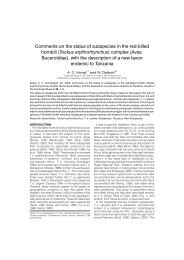EAZA Hornbill Management and Husbandry Guidelines
EAZA Hornbill Management and Husbandry Guidelines
EAZA Hornbill Management and Husbandry Guidelines
Create successful ePaper yourself
Turn your PDF publications into a flip-book with our unique Google optimized e-Paper software.
Familiarity with food items can greatly influence their acceptability to hornbills. For<br />
example, six great hornbills from the other zoos remaining six weeks at a “dating center”<br />
at Arnhem Zoo never lost their preference for items that they were fed in their resident<br />
zoos (M. Damen, pers. comm.). It is therefore important to give hornbills ample time to<br />
adapt to new dietary items.<br />
5.1.3 Colors<br />
P. Poonswad (pers. comm.) noted that Asian hornbills in the wild select fruits which are<br />
predominantly red, orange, dark purple/black. Sunda wrinkled hornbills Aceros<br />
corrugatus at Arnhem Zoo were noted to show a stronger preference for red items when<br />
feeding young (Luttenburg <strong>and</strong> Bisselink, in press). Reddish to blackish fruits may be<br />
high in cartenoids, flavenoids <strong>and</strong> other colored pigments that have been shown to affect<br />
plumage <strong>and</strong> skin color in many bird species. Potential studies on this topic can be found<br />
in Section 8.1.1: Dietary issues.<br />
5.1.4 Fiber<br />
Further investigation of wild fruits provides useful directions for possible diet<br />
improvement. Field researchers M. Kinnaird <strong>and</strong> P. Poonswad have noted that fiber<br />
content of Asian hornbill diets is far higher than in captive diets, <strong>and</strong> suggested that fiber<br />
in captive diets should be increased (Sheppard <strong>and</strong> Worth, 1997). A low amount of<br />
insoluble fiber may provoke a tendency towards watery feces. Increasing dietary fiber<br />
has proven beneficial in some cases with other birds. Addition of ground chitin or wheat<br />
bran improved feces of rollers <strong>and</strong> bee-eaters at the New York Bronx Zoo <strong>and</strong> allowed<br />
the bee-eaters to show normal casting behaviors when kept on a non-insect diet. A<br />
pheasant that consistently plucked its own feathers stopped the behavior when fiber was<br />
added to the diet.<br />
P. Poonswad (pers. comm.) noted that many fruits eaten by hornbills contain large<br />
pits/seeds that the hornbills regurgitate, <strong>and</strong> that this behavior may be important for<br />
healthy functioning of the hornbill digestive system. Uncured olives might serve as<br />
replacement for wild seeds, however, the nutritional value of olives has to be evaluated.<br />
5.1.5 Protein<br />
A study on nitrogen requirements of captive Aceros (three species) <strong>and</strong> Buceros (two<br />
species) hornbills was carried out at the Wildlife Conservation Society. It was found that<br />
the hornbills could maintain body mass on a diet containing 10.8% crude protein (4<br />
Kcal/g dry matter). The results also suggested that Aceros <strong>and</strong> Buceros hornbills have<br />
similar nitrogen requirements. More work needs to be done before these values can be<br />
verified (Foeken <strong>and</strong> de Vries, 2001).<br />
38




